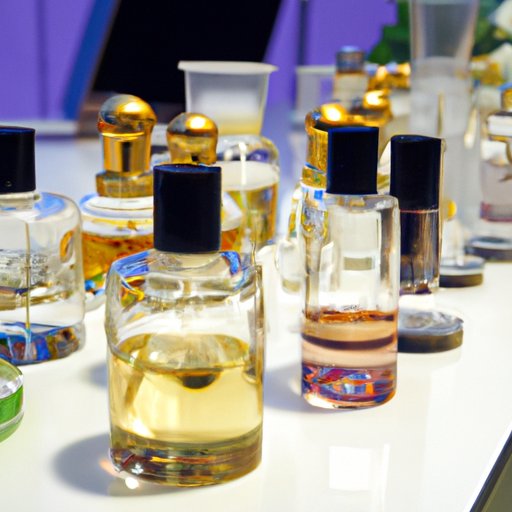Introduction
Perfume is one of the oldest forms of beauty and personal care products known to humans, with its origins tracing back to ancient Egypt and the Middle East. Despite its long history, many people are still unsure about what exactly goes into creating a fragrance. In this article, we will explore what is in perfume, the different types of ingredients used, and the science behind perfume making.

A Comprehensive Guide to What is in Perfume
When it comes to creating a scent, there are two main categories of ingredients used: natural and synthetic. Natural ingredients can include essential oils, floral extracts, spices, resins and other plant materials. Synthetic ingredients, on the other hand, are man-made chemicals that are designed to mimic the aroma of natural ingredients. Both natural and synthetic ingredients are used to create different types of perfume, such as eau de toilette, eau de parfum, and cologne.
The type of ingredients used in a perfume depends on the type of scent the perfumer is trying to achieve. For example, citrusy scents often use natural ingredients such as orange or lemon oil, while woody or musky scents may use synthetic ingredients such as musk or ambergris. Floral scents, meanwhile, tend to use a combination of both natural and synthetic ingredients, depending on the desired effect.

Exploring the Science Behind Perfume Making
The process of creating a perfume is an intricate one that involves blending together a variety of different components. The most common components used in the manufacturing of a perfume are top notes, middle notes, and base notes. These notes are referred to as the “fragrance family tree”, and each note has its own unique aroma that contributes to the overall scent of the perfume.
Top notes are the first scents that you smell when you apply a perfume, and they typically last for about 15 minutes before fading away. They are usually light, fresh scents that give the perfume its initial impression. Examples of top notes include citrus, herbs, and spices.
Middle notes, also known as heart notes, come next and last for up to an hour after application. They are usually more subtle than the top notes and provide a more rounded aroma. Examples of middle notes include jasmine, rose, and lavender.
Base notes are the last scents you smell when wearing a perfume, and they linger for several hours after application. They are usually deeper, heavier scents that provide a strong foundation for the perfume. Examples of base notes include patchouli, vanilla, and sandalwood.
Pros and Cons of Natural vs Synthetic Ingredients
When it comes to choosing between natural and synthetic ingredients, there are pros and cons to both. Synthetic ingredients are often cheaper and easier to source, but they may not be as long-lasting or as true-to-life as natural ingredients. Natural ingredients, on the other hand, can be more expensive and harder to come by, but they can be more complex and offer a wider range of aromas.
Natural ingredients are also beneficial in terms of scent longevity. Essential oils, for example, can provide a longer-lasting scent than synthetic alternatives, as their molecules are larger and take longer to evaporate. This means that a scent made with natural essential oils can last for much longer than one made with synthetic ingredients.
How Do Perfumers Create New Scents?
Creating a new fragrance is a complex process that requires knowledge of both the science and art of scent creation. Perfumers typically begin by selecting a theme or concept for their fragrance, and then they select a series of notes that they think will best represent that concept. These notes are then blended together in varying ratios until the desired effect is achieved.
Several factors can influence the scent creation process, such as the perfumer’s experience and personal preferences, the target audience, the season and time of day, and even the location or environment where the scent will be worn. By taking all of these factors into consideration, a perfumer can create a unique and distinctive scent that will be remembered and enjoyed by those who wear it.
Conclusion
In conclusion, perfume is a complex mixture of various ingredients, both natural and synthetic. Different types of ingredients are used to create different types of scent, and the science behind perfume making involves understanding the different components and how they interact with each other. Natural ingredients can provide a longer-lasting scent and a more complex aroma, while synthetic ingredients are often cheaper and easier to source. Ultimately, it is up to the perfumer to decide which ingredients to use and how to blend them together to create a unique and memorable scent.
If you’d like to learn more about the art and science of perfume making, there are plenty of resources available online to help you get started. From books and blogs to online classes and tutorials, there is an abundance of information out there to help you become an expert in the field.


